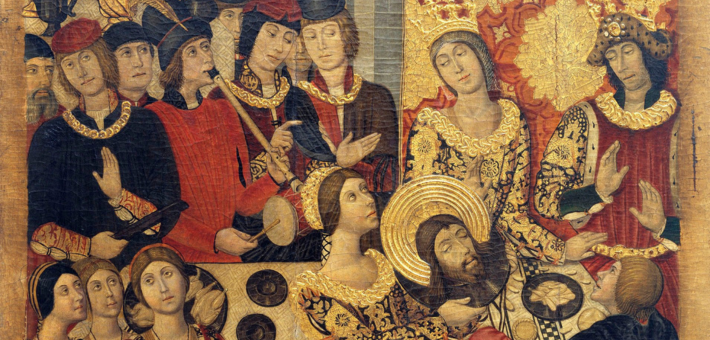Commentary on Amos 7:7-15
Amos is a peculiar prophet in a couple of ways. First, he was a Judean who lived in Tekoa, a small village 12 miles south of Jerusalem, but he prophesied in Israel, far to the north. Second, he was not a professional prophet; his vocation was shepherding and tending fruit trees (7:14–15).
Amos prophesied the downfall of Israel sometime around 850 BCE, and 30 years later the Assyrians conquered Israel and dispersed much of the population. Israel ceased to exist. His message was recorded and passed down through the generations both because his message proved true at the time and because it remained salient for later generations.
It appears that Amos had heard reports about the opulent lifestyle of the ruling class up north and how they enriched themselves by trampling the poor into the dust through dishonest trade, taxes, and bribery. His prophecies focused almost exclusively on the sins of the rich who “oppress the poor and crush the needy” (for example, 2:6–8; 8:4–6)—so exclusively that he is often called “the prophet of social justice.” He denounced the elite class in Samaria and poured scorn on their solemn worship assemblies and sacrifices. He proclaimed that God desires justice and mercy, not extravagant piety and solemn worship (5:18–24; compare to Jesus’ words in Matthew 9:13 and 12:7).
Righteousness begins with justice, and the elite class’s behavior fell far below God’s standard. Amos was fuming while farming until, one day, he set down his tools and headed north to proclaim God’s judgment. His beautiful and compelling poetry, his vivid images and rhetoric, suggest that he was an unusually well-educated farmer for his time. Developing such powerful and sophisticated oracles would have taken time for reflection, knowledge of covenant law, and considerable literary skill. Where and how Amos acquired these we are not told.
Amos 7:7–15 records the last of three vision oracles found in chapter 7. Each oracle has the same poetic form. A fourth vision oracle at the beginning of chapter 8 has a somewhat different form and stands alone. In the first two visions, the Lord shows Amos terrifying punishments against Israel: a locust invasion devouring essential food at the end of the growing season; and a “shower of fire” that devours both the land and the “great deep” (verse 4)—the mythic source of all water. The threat is famine, and the judgments fit the crime. Amos repeatedly condemns the extravagant consumption of wine and food by the wealthy (2:8; 4:1; 5:11; 6:4–6). It was a zero-sum economy; the surfeit of the rich yielded the suffering of the poor.
After each of the first two visions, Amos pleads with the Lord to forgive and relent, and twice the Lord relents. But after the third vision, Amos does not intercede for Israel. The third judgment vision is final: “I will never again pass them by,” says the Lord (7:8). Numbering sins and punishments is one of Amos’s rhetorical tools. In the first two chapters of the book, he records the Lord’s judgment: “For three transgressions of [nation] and for four, I will not revoke the punishment.” At some point, the Lord’s patience runs out.
The exact nature of the threat in the third vision report is uncertain. Traditionally, the Hebrew word )ǎnāk has been translated “plumb line,” a builder’s device for judging if a wall stands true. With this translation the image is clear: Amos sees the Lord testing a wall with a plumb line. The wall stands for Israel, and the plumb line represents the Lord’s standard of judgment. The line reveals that Israel is not plumb; it is crooked, unjust, unrighteous, corrupt.
But scholars are generally agreed that )ǎnāk denotes tin rather than lead. The intended image is less clear in this case. Interpreters are not certain how to understand the function of tin. One common guess is that Amos sees the Lord standing on (not beside) a tin wall with tin in hand. The Lord will set tin in the midst of Israel. Tin was commonly used in making shielding and weapons. A tin wall would be protective, but the Lord wields a tin weapon upon the wall and will destroy their tin wall and set weapons upon them.
Tin is a far less compelling image than a lead plumb line. For one thing, tin connotes something cheap and flimsy to us. Tin evokes neither protection nor threat. For another, the tin imagery is confusing. The Lord stands on a tin wall holding tin and then puts tin among the people of Israel? This requires a lot of ingenious and tedious explanation that is unsatisfying in the end. And in the context of worship based on the commonly used translations, it is a plumb line, not tin, that has been introduced.
Explaining translation issues, especially when the result creates rather than resolves confusion, is a weak rhetorical move. So, even if the English translations are wrong—and this is not absolutely certain—the most effective move is to preach the plumb line image (ignoring the tsking of your seminary professor). In any case, nothing theological is at stake. The point is divine judgment whether we choose tin or lead.
The Lord’s judgment falls specifically on Israel’s worship centers and on the royal house of Jeroboam. These will be laid waste. The royal house has failed to protect the weak and promote justice, and the worship centers have failed to teach the justice the Lord requires and have engendered the false security that assumes that praise and proper worship earn God’s protection (2:8; 4:4–5; 5:21–24). This was a perennial failure of God’s people (Isaiah 1:10–17; Jeremiah 7:1–15). It still is. What God requires is that we “let justice roll down like waters, and righteousness like an ever-flowing stream” (5:24).
Amos’s words were more than “the land” could bear (7:10). Amaziah, the priest at Bethel, reported Amos’s words to the king and told Amos to flee back home to Judah and prophesy there. Amos was undeterred. The Lord had called him, and he must speak: “The lion has roared; who will not fear? The Lord GOD has spoken; who can but prophesy?” (3:8). The high status of the audience and place did not intimidate him, as Amaziah suggested it should.
Several messages stand clear in the book of Amos and in this specific passage. First, God can be persuaded to relent, but divine patience is not limitless. God’s plumb line reveals the true state of things that we have ceased to notice.
Second, God’s first requirement for us is justice and mercy, protection of the poor and vulnerable. God has little interest in our pious displays when the poor are suffering. As St. John Chrysostom says, “If you cannot find Christ in the beggar at the church door, you will not find Him in the chalice.” Those responsible for maintaining justice and providing moral leadership, the royal house and the worship centers, will go down first in the ensuing judgment (7:9).
Third, when God commissions, you must speak, no matter who you are. A farm worker from another country may be the bearer of the truth we need to hear. And perhaps it is this third point that offers a path to preaching Amos that avoids the self-righteous tone so hard to avoid in social justice sermons from comfortable clergy. Where from outside our worship walls do we hear the voice of Amos in our time? Criticism of the church for its obvious failings is common today. How will we respond to outsiders who say we are failing in our core mission to love our neighbors and care for the oppressed? How can we make a clear and effective connection between worship and justice, prayer and service? Where does the church stand in these deadly times?


July 14, 2024